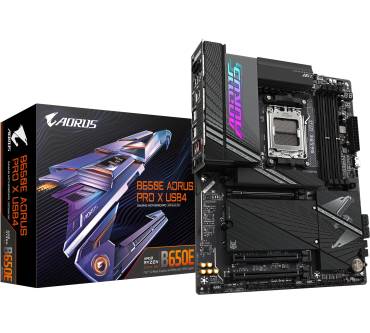First of all, it must be said that the B650E Aorus Pro X USB4 is a very well equipped motherboard that also has what the older models lack – USB4 support. The latter will be commonplace for the new X870(E) models, but those are not available for the Ryzen 9000s from the beginning, after the release of these processors. With the Gigabyte Aorus Pro X USB4, you won’t have to later wonder if “you could have bought a motherboard with USB4 support today”. Sure, there will be some differences in features with the newer motherboards, and most importantly there will be a wider selection, but in this one thing this Gigabyte motherboard is already prepared.
The power delivery for the CPU is robust, well prepared even for overclocking of the most powerful processor that can currently be fitted to it – the AMD Ryzen 9 9950X. The temperature of the voltage regulators is kept below 80 °C under very high load even without a cooler.
We can’t assess the efficiency of the power management yet, for that we will need a larger sample of benchmarked boards tested with the R9 9950X processor. The picture of power efficiency will crystallize only gradually. Anyway, efficient components are used for the VRM, as evidenced by their relatively low temperature at relatively higher power consumption (even in “Eco” mode with a TDP of 105 W). But it also depends on how the motherboard approaches power internally, at the voltage management level.
What is commendable about the Gigabyte Aorus Pro X USB4 is the presence of up to four slots with PCI Express 5.0 support. In addition to the first PCIe ×16 slot, there are also two M.2 slots for SSDs. This is not usual and may not be the case even with all the X870 motherboards.
With the X870E models, manufacturers will probably try to support PCIe 5.0 more extensively, but the tax for this will be a higher price. The B650E Aorus Pro X USB4 is keeping nicely to the ground, at around 305 EUR. However, unfortunately, availability in stores seems to be relatively weaker, which may be one of the biggest drawbacks of this motherboard. However, this may not be true for all markets and certainly not at all times. It certainly makes sense to keep an eye out for availability of the B650E Aorus Pro X USB4.
The Gigabyte B650E Aorus Pro X USB4 uses many of the features typical of the higher-end class, which, in terms of features, it is definitely in. In addition to the robust VRM, which has already been mentioned, and the 7-segment POST display with start and reset buttons, the mechanisms for quick (de)mounting of components are also worth noting. The EZ-Latch system is not only on the M.2 slots, but also on the PCIe ×16 slot and the WiFi antennas are installed via push-pins as well. Then there is also an unconventional HDMI connector for internal display connection on the PCB to monitor CPU, possibly APU, and graphics card activity. And then lots of USB ports, especially external ones. For the internal ones, a second 19-pin would be really nice. You won’t be able to connect a third and fourth USB 3.2 gen. 1 connector on cases to the B650E Aorus Pro X USB4 board.
The SSD cooler on the first slot is efficient, the shared one (for three M.2 slots) only partially.A larger temperature difference between the controller and the memory seems to indicate worse contact (cooler to SSD), as is the case with the Gigabyte Z790 Aorus Pro X motherboard as well. Measured M.2 slot speeds or USB port speeds are fine and do not deviate from the standards that define them. We only saw worse results with Ethernet at about half the expected speed. However, it cannot be ruled out that this is just an “anomaly of the test piece”.
Overall, we rate the Gigabyte B650E Aorus Pro X USB4 motherboard positively. Abundant features for affordable money. If the individual components were getting scored to compile some relative ranking, the value for money coefficient would probably be very high.








